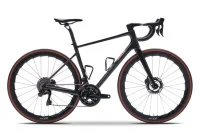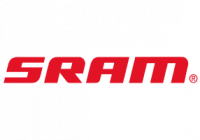Chronic Saddle Discomfort – Part 2. Pelvic Over Rotation.
There are a host of combined technique items that often relate to saddle issues and trying to explain all of them at once would be overwhelming. Proper bike fit/set-up and saddle selection can solve saddle issues for many riders, but problems often persist for others when there are technique and postural elements that go beyond bike fit and equipment selection. Numbness and pressure on the groin/perineum area while riding is likely the number one saddle related complaint. In the last installment we discussed how toe pointing can contribute to pressure like this. This installment will hit another common contributor, especially in riders with hyper-mobility of the joints, hyper-extension of the back into lordosis and the often associated over rotation of the pelvis.
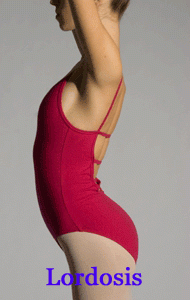 While more riders likely under-rotate their pelvis than over-rotate while riding (a future article…), riders who over-rotate their pelvis and hyper-extend their lower back into lordosis are some of the most prone to experiencing chronic saddle numbness and pressure in the soft tissue at the front of the saddle. The reason is simple, if you rotate your pelvis too far forward and don’t support it with your abdominal muscles effectively you simply drive the soft tissue straight into the nose of the saddle. Other than a noseless saddle (which has a number of other potential compromises when it comes to pelvic stabilization), a proper bike fit or any host of different saddles will not fully resolve a saddle issue caused by this; as long as the rider continues to over-rotate and under support their pelvis, they will have pressure up-front. While the reason might be simple, training yourself into the technique that solves it can be far more challenging.
While more riders likely under-rotate their pelvis than over-rotate while riding (a future article…), riders who over-rotate their pelvis and hyper-extend their lower back into lordosis are some of the most prone to experiencing chronic saddle numbness and pressure in the soft tissue at the front of the saddle. The reason is simple, if you rotate your pelvis too far forward and don’t support it with your abdominal muscles effectively you simply drive the soft tissue straight into the nose of the saddle. Other than a noseless saddle (which has a number of other potential compromises when it comes to pelvic stabilization), a proper bike fit or any host of different saddles will not fully resolve a saddle issue caused by this; as long as the rider continues to over-rotate and under support their pelvis, they will have pressure up-front. While the reason might be simple, training yourself into the technique that solves it can be far more challenging.
First, what do we mean by “over-rotate” the pelvis and “too much anterior rotation”? While we encourage a neutral and forward athletic stance while riding, this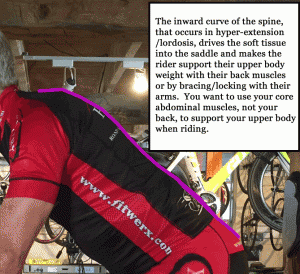 requires that the rider use their core/stomach muscles and stabilizers (like the obliques) to support their upper body weight and stabilize their pelvis. When done properly, this position provides excellent access to all the key pedaling muscle groups and allows the rider to remain stable and balanced in the saddle while being relaxed and light on the handlebars. However, if a rider takes this concept too far (over-rotation and not supporting with their core muscles adequately), bad things can happen and one of those is too much pressure on the perineum and soft tissue from the front of the saddle.
requires that the rider use their core/stomach muscles and stabilizers (like the obliques) to support their upper body weight and stabilize their pelvis. When done properly, this position provides excellent access to all the key pedaling muscle groups and allows the rider to remain stable and balanced in the saddle while being relaxed and light on the handlebars. However, if a rider takes this concept too far (over-rotation and not supporting with their core muscles adequately), bad things can happen and one of those is too much pressure on the perineum and soft tissue from the front of the saddle.
Lordosis is basically excessive inward curvature of the spine. More prevalent for women when riding than men (but not exclusive), and also more common among those with looser joints and greater flexibility, a lordotic spine on a bike makes it very easy to drive your weight too far forward and down into the front of the saddle. Frequently, the lordotic rider will depend on locking her joints and her back muscles to try to support her upper body rather than the stronger, more stable and greater endurance muscles of the stomach. Lordotic riders frequently brace/lock their arms and hold significant tension in their neck and shoulders. Likewise, they often also suffer from numb hands. So not over-rotating the pelvis forward is important for far more reasons beyond just saddle comfort.
From a musculature standpoint, your goal when pedaling is to use your core/abdominal muscles to keep yourself stable in the saddle while supporting the weight of your torso (thus allowing you to relax your extremities and joints). This has similarities to the posture and muscles you would use in the “ready” position in a ball 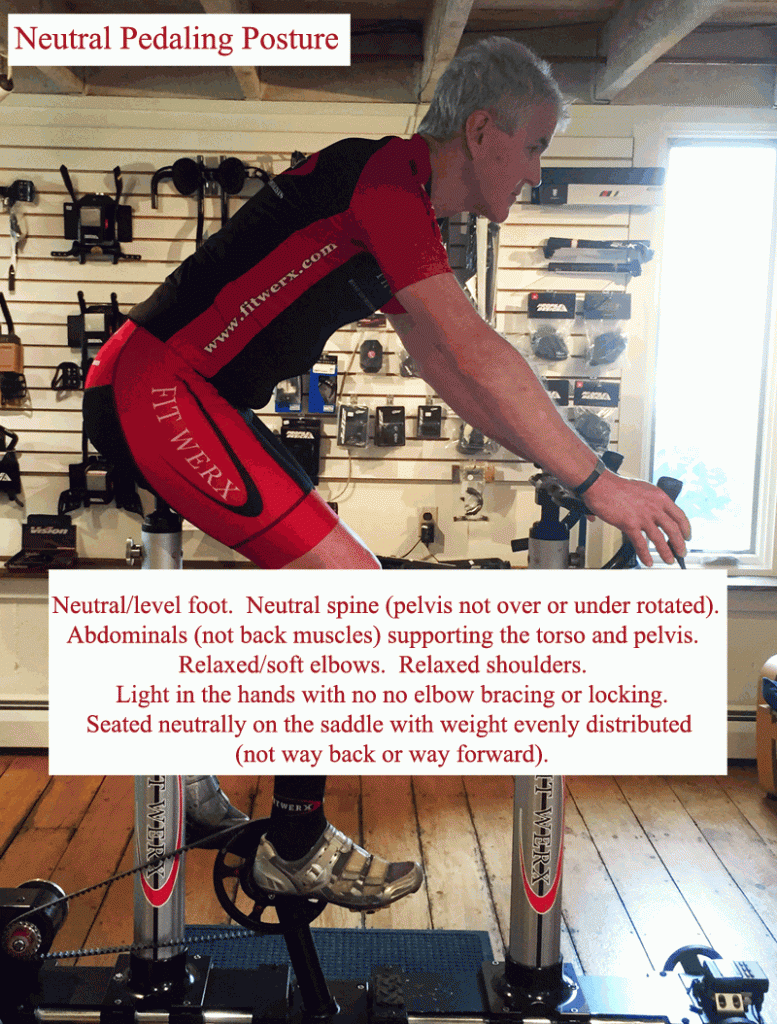 sport (pelvis rotates slightly forward, quads/hamstrings/abdominals all working together to support your pelvis and torso so you are relaxed in the upper body and hands). If you master this fundamental posture in general riding, you will find that keeping weight off the front of the saddle and keeping it more in your sit bones becomes a lot easier and that your desire to hunch or hyper-extend your back, brace with straight arms, or slide forward will diminish greatly.
sport (pelvis rotates slightly forward, quads/hamstrings/abdominals all working together to support your pelvis and torso so you are relaxed in the upper body and hands). If you master this fundamental posture in general riding, you will find that keeping weight off the front of the saddle and keeping it more in your sit bones becomes a lot easier and that your desire to hunch or hyper-extend your back, brace with straight arms, or slide forward will diminish greatly.
While bike set-up/fit can be very important to helping make sure a rider is able to support themselves properly when riding and can 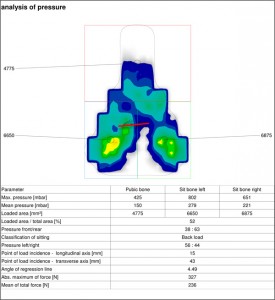 encourage you to use the correct posture and muscles, it can’t force it to happen. Your bike could fit perfectly and if you insist on riding with too much anterior pelvic rotation and a locked/lordotic back, you will likely still have saddle comfort problems. This is why, in a Fit Werx fitting, we spend a significant portion of time with many riders discussing and documenting/showing their posture and pedaling technique on the bike. In the case of weight distribution on the saddle, one tool a Fit Werx fitting employs to help you better understand what you are doing that could be contributing to your saddle issues is the gebioMized saddle scanner. By having a visual indicator of where the pressure is on your saddle, it can be much easier for you to understand where the problem is originating and understand what you need to do to change it.
encourage you to use the correct posture and muscles, it can’t force it to happen. Your bike could fit perfectly and if you insist on riding with too much anterior pelvic rotation and a locked/lordotic back, you will likely still have saddle comfort problems. This is why, in a Fit Werx fitting, we spend a significant portion of time with many riders discussing and documenting/showing their posture and pedaling technique on the bike. In the case of weight distribution on the saddle, one tool a Fit Werx fitting employs to help you better understand what you are doing that could be contributing to your saddle issues is the gebioMized saddle scanner. By having a visual indicator of where the pressure is on your saddle, it can be much easier for you to understand where the problem is originating and understand what you need to do to change it.
Fit Werx, voted “America’s Best Bike Shop” and named by Bicycling Magazine as a “Must Visit” bike shop, has locations outside of NYC in Ridgefield Park, NJ, in Peabody and Lexington, MA and near Burlington, VT and Stowe, VT in Waitsfield. Fit Werx is changing the way people buy bicycles through their Rider First Bike Fittings and Rider Matched approach to bike sales. Don’t gamble on your next bike or your fit! Contact us for more information.








